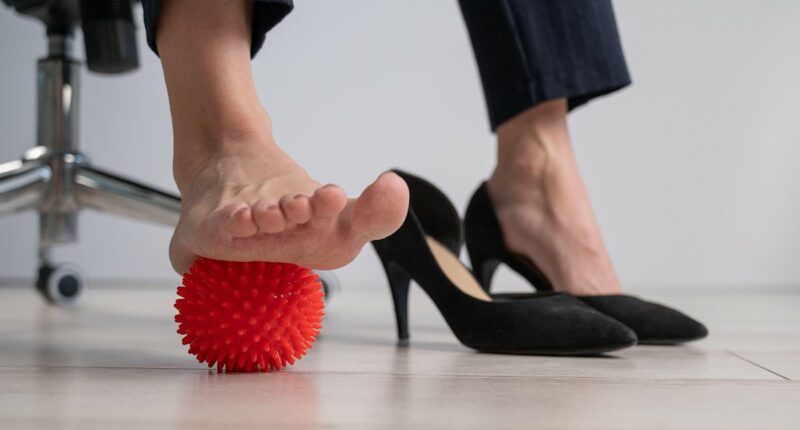Share this @internewscast.com
When Anne Larchy completed a 26-mile charity walk in the summer of 2019, she expected a few days of sore feet.
However, weeks later, the 53-year-old health coach from north London continued to endure intense discomfort. “I’d wake up with pain in my right heel that lasted all day,” she describes. “Even walking around the house became exhausting.”
After a fortnight, Anne realised it wasn’t a pulled muscle.
A physiotherapist swiftly identified the issue as plantar fasciitis, an inflammation of the tissue lining the sole of the foot, which impacts roughly one in ten adults in the UK.
Most frequently occurring between the ages of 40 and 60, it is caused by walking on hard surfaces, wearing unsupportive footwear, or being overweight. The pain can linger for months, or even years.
Experts, however, say that in most cases, it’s possible to relieve – and even cure – the condition with simple lifestyle changes rather than surgery.

Plantar fasciitis can be managed – and even cured – with simple lifestyle changes rather than surgery
“The role of the plantar fascia is to absorb shock and support the arch of the foot,” explains Dr John Veto, a senior lecturer in podiatry at the University of Stirling.
“When it becomes overloaded—whether from excessive exercise, prolonged standing, or additional weight—it gets inflamed, resulting in shooting pains in the heel.”
Pain is typically at its worst first thing in the morning, when getting out of bed, or after sitting for a while.
“We often observe plantar fasciitis in individuals who suddenly increase their activity levels, like those training for a marathon, or who have recently gained weight, as this can place extra pressure on the feet,” states Dr Veto.
The condition can also be linked to hormonal changes, particularly during the menopause, when a drop in oestrogen reduces the elasticity of soft tissue in the feet that can lead to the development of microtears and inflammation.
It’s also a seasonal problem, says Dr Libertad Rodriguez Burgos, a podiatry lecturer at the University of Brighton. ‘We often see a spike in cases at the end of summer – after people have spent holidays walking for miles in flimsy sandals, flip-flops or ballet pumps,’ she explains.
However, experts warn that not all foot pain is plantar fasciitis. ‘Plantar fasciitis pain tends to build gradually,’ says Dr Rodriguez Burgos. ‘If it comes on suddenly and feels sharp or intense, it’s more likely to be a fracture or trapped nerve.’
Once the condition is confirmed, the first step is to cut back on high-impact activities such as running or jumping.
‘Instead, focus on strengthening the calves,’ advises Devon-based physiotherapist Dr Esther Fox.
‘Stronger calf muscles take pressure off the plantar fascia and support the arch of the foot.’
The most effective move, she says, is a simple heel raise – stand with the balls of your feet on the edge of a step, then slowly lift and lower your heels. ‘If your calves or heels are too sore, start gently and build up, but try to do a few sets every day,’ she adds.
Stretching and massaging the foot can also help loosen the tissue and boost blood flow. ‘Roll a ball or cold can under the arch of your foot, or gently pull your toes back towards you before standing in the morning,’ says Dr Rodriguez Burgos. ‘It can bring quick relief and help reduce inflammation.’
Footwear is a crucial factor. ‘Any shoe with arch support and a cushioned heel will help,’ says Dr Veto. ‘Trainers that lace up are much better than slip-ons, as they hold the foot in place and provide more stability.’
Those with very flat feet or high arches may benefit from orthotics – custom inserts that can be made by a podiatrist and worn in any shoe to redistribute pressure.
In most cases, plantar fasciitis will clear up on its own within six to 12 months. But for stubborn cases, additional treatments may be needed.
Treatments include steroid injections to ease inflammation or extracorporeal shockwave therapy (ESWT) – a non-invasive procedure that uses sound waves to boost blood flow and healing.
Anne tried this approach after a year of agony, paying around £1,000 privately. ‘After the second session, I started getting short pain-free periods,’ she says. ‘By the third, it began to fade. Within six weeks, it had gone completely. It was incredible.’
‘Shockwave therapy is relatively new, but there’s good evidence it works,’ says Dr Veto. ‘The problem is access – only a few NHS areas offer it.’
Still, the prognosis is positive. ‘About 80 per cent of plantar fasciitis cases get better with time,’ says Dr Fox. ‘With supportive shoes, daily stretching and gradual exercise, most people can manage it themselves.’
For Anne, recovery has been life-changing. ‘After so long in pain, I’d forgotten what normal felt like,’ she says. ‘Now I can walk for miles again.’















